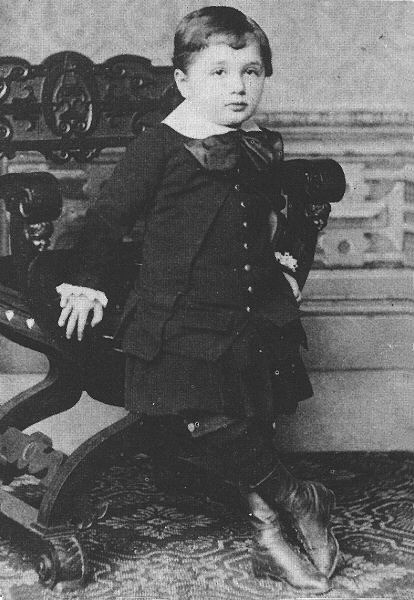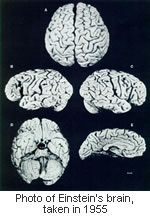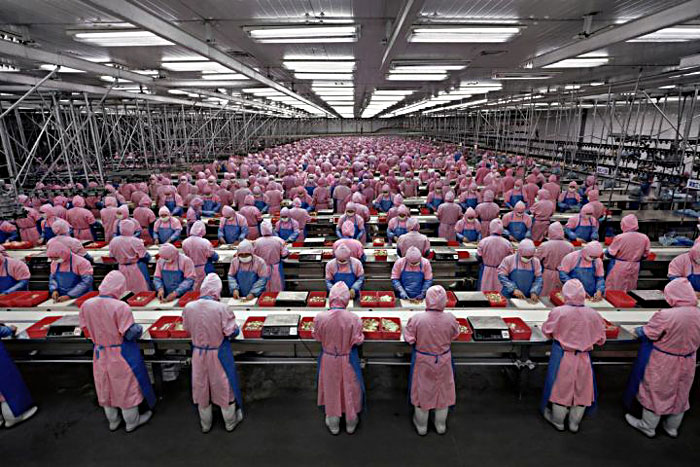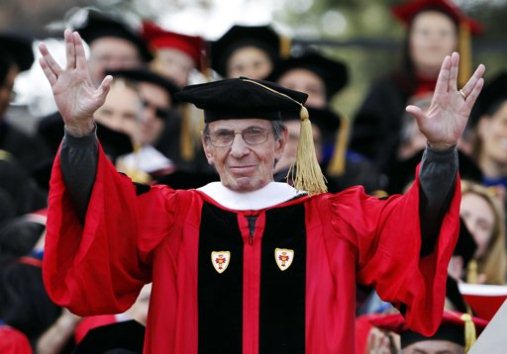Albert Einstein in a famous 1951 photo by Arthur Sasse.
So you think you know Albert Einstein: the absent-minded genius who
gave us the theory of relativity (two of them, in fact, special theory
and general theory of relativity), but did you know that Einstein was
born with such a large head that his mother thought he was deformed? Or
that Einstein had a secret child before he was married?
Read on for more obscure facts about the life of the world’s smartest genius:
1. Einstein Was a Fat Baby with Large Head
When Albert’s mother, Pauline Einstein gave birth to him, she thought
that Einstein’s head was so big and misshapen that he was deformed!
As the back of the head seemed much too big, the
family initially considered a monstrosity. The physician, however, was
able to calm them down and some weeks later the shape of the head was
normal. When Albert’s grandmother saw him for the first time she is
reported to have muttered continuously "Much too fat, much too fat!"
Contrasting all apprehensions Albert grew and developed normally except
that he seemed a bit slow. (Source)
2. Einstein Had Speech Difficulty as a Child

Earliest Known Photo of Albert Einstein (Image credit: Albert Einstein Archives,
The Hebrew University of Jerusalem, Israel)
As a child, Einstein seldom spoke. When he did, he spoke very slowly –
indeed, he tried out entire sentences in his head (or muttered them
under his breath) until he got them right before he spoke aloud.
According to accounts, Einstein did this until he was nine years old.
Einstein’s parents were fearful that he was retarded – of course, their
fear was completely unfounded!
One interesting anecdote, told by Otto Neugebauer, a historian of science, goes like this:
As he was a late talker, his parents were worried. At
last, at the supper table one night, he broke his silence to say, "The
soup is too hot."
Greatly relieved, his parents asked why he had never said a word before.
Albert replied, "Because up to now everything was in order." (Source)
In his book,
Thomas Sowell
[wiki] noted that besides Einstein, many brilliant people developed
speech relatively late in childhood. He called this condition The
Einstein Syndrome.
3. Einstein was Inspired by a Compass
When Einstein was five years old and sick in bed, his father showed
him something that sparked his interest in science: a compass.
When Einstein was five years old and ill in bed one
day, his father showed him a simple pocket compass. What interested
young Einstein was whichever the case was turned, the needle always
pointed in the same direction. He thought there must be some force in
what was presumed empty space that acted on the compass. This incident,
common in many "famous childhoods," was reported persistently in many of
the accounts of his life once he gained fame. (Source)
4. Einstein Failed his University Entrance Exam
In 1895, at the age of 17, Albert Einstein applied for early
admission into the Swiss Federal Polytechnical School (Eidgenössische
Technische Hochschule or ETH). He passed the math and science sections
of the entrance exam, but failed the rest (history, languages,
geography, etc.)! Einstein had to go to a trade school before he retook
the exam and was finally admitted to ETH a year later. (
Source)
5. Einstein had an Illegitimate Child
In the 1980s, Einstein’s private letters revealed something new about
the genius: he had an illegitimate daughter with a fellow former
student Mileva Marić (whom Einstein later married).
In 1902, a year before their marriage, Mileva gave birth to a
daughter named Lieserl, whom Einstein never saw and whose fate remained
unknown:
Mileva gave birth to a daughter at her parents’ home
in Novi Sad. This was at the end of January, 1902 when Einstein was in
Berne. It can be assumed from the content of the letters that birth was
difficult. The girl was probably christianised. Her official first name
is unknown. In the letters received only the name “Lieserl” can be
found.
The further life of Lieserl is even today not totally clear.
Michele Zackheim concludes in her book “Einstein’s daughter” that
Lieserl was mentally challenged when she was born and lived with
Mileva’s family. Furthermore she is convinced that Lieserl died as a
result of an infection with scarlet fever in September 1903. From the
letters mentioned above it can also be assumed that Lieserl was put up
for adoption after her birth.
In a letter from Einstein to Mileva from September 19, 1903,
Lieserl was mentioned for the last time. After that nobody knows
anything about Lieserl Einstein-Maric. (Source)
6. Einstein Became Estranged From His First Wife, then Proposed a Strange "Contract"

After
Einstein and Mileva married, they had two sons: Hans Albert and Eduard.
Einstein’s academic successes and world travel, however, came at a
price – he became estranged from his wife. For a while, the couple tried
to work out their problems – Einstein even proposed a strange
"contract" for living together with Mileva:
The relationship progressed. Einstein became
estranged from his wife. The biography reprints a chilling letter from
Einstein to his wife, a proposed "contract" in which they could continue
to live together under certain conditions. Indeed that was the heading:
"Conditions."
A. You will make sure
1. that my clothes and laundry are kept in good order;
2. that I will receive my three meals regularly in my room;
3. that my bedroom and study are kept neat, and especially that my desk is left for my use only.
B. You will renounce all personal relations with me insofar as they are not completely necessary for social reasons…
There’s more, including "you will stop talking to me if I request
it." She accepted the conditions. He later wrote to her again to make
sure she grasped that this was going to be all-business in the future,
and that the "personal aspects must be reduced to a tiny remnant." And
he vowed, "In return, I assure you of proper comportment on my part,
such as I would exercise to any woman as a stranger." (Source)
7. Einstein Didn’t Get Along with His Oldest Son

After
the divorce, Einstein’s relationship with his oldest son, Hans Albert,
turned rocky. Hans blamed his father for leaving Mileva, and after
Einstein won the Nobel Prize and money, for giving Mileva access only to
the interest rather than the principal sum of the award – thus making
her life that much harder financially.
The row between the father and son was amplified when Einstein strongly objected to Hans Albert marrying Frieda Knecht:
In fact, Einstein opposed Hans’s bride in such a
brutal way that it far surpassed the scene that Einstein’s own mother
had made about Mileva. It was 1927, and Hans, at age 23, fell in love
with an older and – to Einstein – unattractive woman. He damned the
union, swearing that Hans’s bride was a scheming woman preying on his
son. When all else failed, Einstein begged Hans to not have children, as
it would only make the inevitable divorce harder. … (Source: Einstein A to Z by Karen C. Fox and Aries Keck, 2004)
Later, Hans Albert immigrated to the United States became a professor
of Hydraulic Engineering at UC Berkeley. Even in the new country, the
father and son were apart. When Einstein died, he left very little
inheritance to Hans Albert.
More about Hans Albert:
Obituary by UC Berkeley
8. Einstein was a Ladies’ Man

Einstein with his second wife and cousin, Elsa (
Image credit)
After Einstein divorced Mileva (his infidelity was listed as one of
the reasons for the split), he soon married his cousin Elsa Lowenthal.
Actually, Einstein also considered marrying Elsa’s daughter (from her
first marriage) Ilse, but she demurred:
Before marrying Elsa, he had considered marrying her
daughter, Ilse, instead. According to Overbye, “She (Ilse, who was 18
years younger than Einstein) was not attracted to Albert, she loved him
as a father, and she had the good sense not to get involved. But it was
Albert’s Woody Allen moment.” (Source)
Unlike Mileva, Elsa Einstein’s main concern was to take care of her
famous husband. She undoubtedly knew about, and yet tolerated,
Einstein’s infidelity and love affairs which were later revealed in his
letters:
Previously released letters suggested his marriage in
1903 to his first wife Mileva Maric, mother of his two sons, was
miserable. They divorced in 1919, and he soon married his cousin, Elsa.
He cheated on her with his secretary, Betty Neumann.
In the new volume of letters released on Monday by Hebrew
University in Jerusalem, Einstein described about six women with whom he
spent time and from whom he received gifts while being married to Elsa.
Some of the women identified by Einstein include Estella, Ethel,
Toni and his "Russian spy lover," Margarita. Others are referred to only
by initials, like M. and L.
"It is true that M. followed me (to England) and her chasing
after me is getting out of control," he wrote in a letter to Margot in
1931. "Out of all the dames, I am in fact attached only to Mrs. L., who
is absolutely harmless and decent." (Source)
9. Einstein, the War Pacifist, Urged FDR to Build the Atom Bomb

Re-creation of Einstein and Szilárd signing the famous letter to President Franklin Roosevelt in 1939. (Image credit:
Wikipedia)
In 1939, alarmed by the rise of Nazi Germany, physicist
Leó Szilárd
[wiki] convinced Einstein to write a letter to president Franklin
Delano Roosevelt warning that Nazi Germany might be conducting research
into developing an atomic bomb and urging the United States to develop
its own.
The Einstein and Szilárd’s letter was often cited as one of the reasons Roosevelt started the secret
Manhattan Project
[wiki] to develop the atom bomb, although later it was revealed that
the bombing of Pearl Harbor in 1941 probably did much more than the
letter to spur the government.
Although Einstein was a brilliant physicist, the army considered
Einstein a security risk and (to Einstein’s relief) did not invite him
to help in the project.
10. The Saga of Einstein’s Brain: Pickled in a Jar for 43 Years and Driven Cross Country in a Trunk of a Buick!

After his death in 1955,
Einstein’s brain [wiki] was removed – without permission from his family – by
Thomas Stoltz Harvey
[wiki], the Princeton Hospital pathologist who conducted the autopsy.
Harvey took the brain home and kept it in a jar. He was later fired from
his job for refusing to relinquish the organ.
Many years later, Harvey, who by then had gotten permission from Hans
Albert to study Einstein’s brain, sent slices of Einstein’s brain to
various scientists throughout the world. One of these scientists was
Marian Diamond of UC Berkeley, who discovered that compared to a normal
person, Einstein had significantly more glial cells in the region of the
brain that is responsible for synthesizing information.
In another study, Sandra Witelson of McMaster University found that
Einstein’s brain lacked a particular "wrinkle" in the brain called the
Sylvian fissure. Witelson speculated that this unusual anatomy allowed
neurons in Einstein’s brain to communicate better with each other. Other
studies had suggested that Einstein’s brain was denser, and that the
inferior parietal lobe, which is often associated with mathematical
ability, was larger than normal brains.
The saga of Einsteins brain can be quite strange at times: in the
early 1990s, Harvey went with freelance writer Michael Paterniti on a
cross-country trip to California to meet Einstein’s granddaughter. They
drove off from New Jersey in Harvey’s Buick Skylark with Einstein’s
brain sloshing inside a jar in the trunk! Paterniti later wrote his
experience in the book
Driving Mr. Albert: A Trip Across America with Einstein’s Brain
In 1998, the 85-year-old Harvey delivered Einstein’s brain to Dr.
Elliot Krauss, the staff pathologist at Princeton University, the
position Harvey once held:
… after safeguarding the brain for decades like it
was a holy relic — and, to many, it was — he simply, quietly, gave it
away to the pathology department at the nearby University Medical Center
at Princeton, the university and town where Einstein spent his last two
decades.
"Eventually, you get tired of the responsibility of having it. … I
did about a year ago," Harvey said, slowly. "I turned the whole thing
over last year [in 1998]." (Source)
















 As
much chaos and grief as Adolph Hitler gave Europe, his aspirations were
much, much worse. Luckily, not all those plans turn out the way he
wanted. Some were never implemented, for god reason. And others, like
the V-weapons program, did not live up to the specifications.
As
much chaos and grief as Adolph Hitler gave Europe, his aspirations were
much, much worse. Luckily, not all those plans turn out the way he
wanted. Some were never implemented, for god reason. And others, like
the V-weapons program, did not live up to the specifications.





 The
next time your teacher scolds you for "zoning out," refer him
to this study by psychologists Benjamin Baird and Jonathan Schooler at
the University of California Santa Barbara:
The
next time your teacher scolds you for "zoning out," refer him
to this study by psychologists Benjamin Baird and Jonathan Schooler at
the University of California Santa Barbara:




 Redefine drought, agency urges
Redefine drought, agency urges


 After
Einstein and Mileva married, they had two sons: Hans Albert and Eduard.
Einstein’s academic successes and world travel, however, came at a
price – he became estranged from his wife. For a while, the couple tried
to work out their problems – Einstein even proposed a strange
"contract" for living together with Mileva:
After
Einstein and Mileva married, they had two sons: Hans Albert and Eduard.
Einstein’s academic successes and world travel, however, came at a
price – he became estranged from his wife. For a while, the couple tried
to work out their problems – Einstein even proposed a strange
"contract" for living together with Mileva: After
the divorce, Einstein’s relationship with his oldest son, Hans Albert,
turned rocky. Hans blamed his father for leaving Mileva, and after
Einstein won the Nobel Prize and money, for giving Mileva access only to
the interest rather than the principal sum of the award – thus making
her life that much harder financially.
After
the divorce, Einstein’s relationship with his oldest son, Hans Albert,
turned rocky. Hans blamed his father for leaving Mileva, and after
Einstein won the Nobel Prize and money, for giving Mileva access only to
the interest rather than the principal sum of the award – thus making
her life that much harder financially.

 After his death in 1955,
After his death in 1955,  Rewritable DNA memory shown off
Rewritable DNA memory shown off



